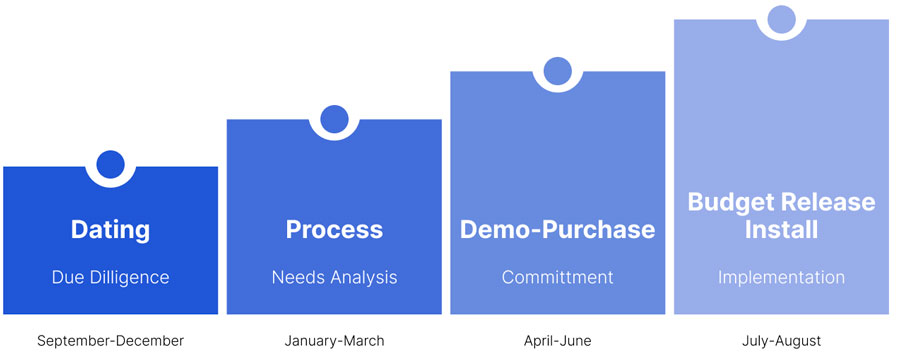Back to The EDiT Journal
Entering the U.S. EdTech Market: 5 Keys for Success
Learn about entering the U.S. Edtech market with 5 keys for success that will help you position your business for growth and prosperity.



In this article
1. One size does not fit all
2. Standards alignment is critical
3. Eat the pie one slice at a time
4. Sync with seasons
5. Become a storyteller
Last week, as education leaders gathered in Philadelphia for ISTE Live 23, one of the world’s most comprehensive Edtech events, it was evident that the United States remains a beacon of opportunity for companies seeking to tap into one of the world’s largest and most lucrative markets. However, entering the U.S. market is a complex endeavor and understanding the key factors for success is crucial. Continue reading for the 5 keys for success from EDT’s U.S. Consultants that will help you position your business for growth and prosperity in the U.S. market.
The US Edtech market size was valued at US$ 129 Billion in 2022 and is expected to accumulate a value of US$ 421 billion by 2032, registering a CAGR of 12.9% in the forecast period of 2023 to 2032.
1. One size does not fit all
With approximately 13,800 public school districts in the United States collectively educating about 55.2 million students, it’s evident a one-size-fits-all approach is ineffective. The first key to success is to understand that the U.S. is a fractured market. You have federal government mandates, state government mandates and even local government mandates that all drive a school district’s policy.
- One approach will not work for all states (or even school districts). Teachers, administrators and students are already overwhelmed with choices. Identify your target audience’s pain points and make sure your benefits are a good fit for their specific needs and wants.
- Do not over-elaborate or build on half-baked features. Chances are that somebody else is already doing what you do. Ensure that you highlight your unique value proposition and concentrate on differentiating what your product does better than others.
2. Standards alignment is critical
Standards alignment refers to the process of ensuring that your educational content or product aligns with the specific academic standards set by educational authorities or institutions in the United States. These standards outline the knowledge and skills that students are expected to learn at each grade level. Standards alignment directly impacts the adoption and success of your product in the U.S. education system. Especially if you are providing content, standards alignment is critical.
- Research and identify which standards to align to and clearly communicate the alignment. This may include national standards, such as the Common Core State Standards, as well as state-specific standards.
- Although teachers and school leaders care more about the actual content, without alignment they cannot get funding and approvals easily. They rely on funding from federal, state, or local sources and to secure funding or gain approvals for the use of educational technology, content, or products, it is essential to demonstrate how your offering aligns with the relevant academic standards
3. Eat the pie one slice at a time
Launching an Edtech solution across all 50 states of the United States is an impossible task. Instead, success lies in a more strategic and focused approach. Rather than attempting a nationwide launch, concentrate your efforts where you will have the greatest impact and gradually expand from there.
- Don’t try to target the entire country at once, instead try a more strategic approach. Select which states you want to focus on initially and gradually expand in a systematic way.
- Attend regional conferences where you can connect and build relationships with potential customers and partners. Regional conferences, though smaller, can prove to be more effective than the larger national conferences.
4. Sync with seasons
It’s essential to consider the education sector’s budget cycles and seasonality at the time of deciding when to launch and what actions to take.
- Fall (September to December): This period is ideal for engaging in thought leadership activities. Consider sharing content through blog articles, white papers, and webinars, and attending and speaking at conferences and events.
- Spring (January to April) – Spring is a critical period for gathering detailed information and finalizing implementation plans for the following academic year. Provide detailed information and implementation details. If your solution is large and complex, this is also the time to get into school budgets for the following academic year.
- Summer (May to August) – The summer season is when budgets are finalized, items are purchased and staff training occurs.

5. Become a storyteller
Everybody loves a good story — Americans, arguably, love a good story the most. A compelling narrative can help your product stand out in the competitive U.S. Edtech market.
- Make sure you communicate your value proposition and the benefits of your product in an articulate, convincing and engaging way.
- People are more likely to remember stories compared to plain facts or data. By weaving your product’s value proposition into a captivating narrative, you increase the chances of your message sticking with your audience, including decision-makers making purchasing decisions.
Navigating the U.S. Edtech market can be a challenging endeavor — from understanding the importance of standards alignment to strategically considering budget cycles and seasonality, these keys offer valuable insights to position your business for growth and success.

.png)

.jpg)

